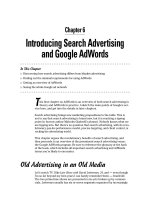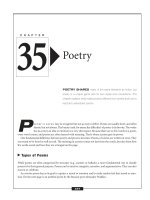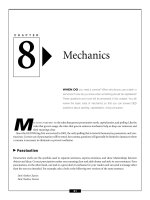graphic arts advertising
Bạn đang xem bản rút gọn của tài liệu. Xem và tải ngay bản đầy đủ của tài liệu tại đây (43.85 KB, 4 trang )
Graphic Arts
Graphic arts is a general term for drawing and other techniques used to reproduce words and
pictures. The techniques include block printing, engraving, etching, lithography, and silk-screen
printing. Painting was once considered one of the graphic arts, but today it is generally considered
a separate art form.
The graphic arts are used both commercially and in the fine arts. Commercially, they are used in
advertising to prepare newspaper and magazine illustrations, posters, and brochures and
pamphlets. Other commercial uses include art reproduction, bookmaking, interior design and
fashion design. In the fine arts, many artists have created masterpieces of engraving, etching, and
other graphic arts. These artists include Albrecht Durer of Germany, Francisco Goya and Pablo
Picasso of Spain, and Rembrandt Van Rijn of the Netherlands.
Advertising
I am currently studying Graphic Design, which uses many of the graphic art techniques in it's
execution. When I graduate, I intend to go into the Advertising world, I hope to be developing
dynamic concepts for 'Above the line' advertising (TV commercials, etc). I researched Advertising
to learn more about my future career.
Advertising is a message designed to promote a product, a service, or an idea. In many countries,
people come into daily contact with many kinds of advertising. Printed advertisements make up a
large part of newspapers and magazines. Poster advertisements appear in many buses, and in
shops and other public buildings. Commercials are advertisements which interrupt TV and radio
programmes. Other types of advertisements are called adverts or ads.
The purpose of most advertising is to sell products or services. Manufacturers advertise to try to
persuade people to buy their products. Large business firms also use advertising to create a
favourable "image" of their company. They want the company name to be known and respected
for the products the firm makes or the services it provides. Local businesses use advertising to
gain new customers and increase sales. Advertising thus plays a part in the competition among
businesses for the consumer's money. It is the cheapest and fastest way to inform large numbers
of people about products or services for sale and to persuade them to buy. In many businesses, the
volume of sales depends largely on the amount of advertising done.
The United States has the world's largest advertising industry. Television commercials take up
more viewing time than in other countries. All television and radio costs are paid by advertising.
Other countries with large advertising industries include France, Germany, Japan, and the United
Kingdom.
Where advertising is widespread it has enormous influence on people's lives. Advertising
encourages people to eat certain foods, wear certain clothes, drive certain cars, and use certain
household products. It promotes the use of labour-saving appliances and then suggests ways to
enjoy the resulting leisure time. In doing all these things, advertising helps shape tastes, habits,
attitudes, and culture of a country. In promoting the sale of many kinds of goods, advertising can
help raise the standard of living.
Advertising is common in almost all countries. In many countries, however, the use of advertising
is restricted. In most countries of Western Europe, for example, the governments limit the amount
of advertising on television and the types of product that may be advertised. In Norway and
Sweden television advertising is illegal.
Ways of advertising
Advertising reaches people through various forms of mass communication. These media include
newspapers, magazines, television, and radio. Advertisers buy space in newspapers and
magazines to publish their ads. They buy time on television and radio to broadcast their
commercials. National advertisers, such as airlines and food companies, use the media to reach
consumers throughout large parts of the country or all of it. Local advertisers, such as department
stores, supermarkets, and restaurants, use the media to reach consumers within a district or town.
The chief advertising media are (1) newspapers, (2) television, (3) direct mail, (4) radio, (5)
magazines, and (6) outdoor signs. Newspapers and TV receive the largest share of the money
spent on advertising.
Newspapers
Newspapers offer advertisers several advantages over other media. Most adults read a daily
newspaper, and many of them specifically check the ads for information about products, services,
or special sales. Daily newspapers also offer the advantage of timeliness. An advertiser can
prepare and publish an advertisement within a day. Newspaper ads can thus quickly reflect a
sudden demand for certain merchandise or use a theme that relates to current news.
Newspapers carry two main kinds of advertisements: display ads and classified ads. Display ads
range in size from less than 2.5 centimetres to a full page or more, and most include illustrations.
Advertisers can appeal to people with special interests by placing their ads on certain pages, such
as those devoted to travel, home life, or sports. Classified ads appear in a separate section of a
newspaper. Most classified ads consist of a few lines of print. The ads list homes, used cars,
furniture, and other property that individuals have for sale. Used-car dealers, and firms with job
vacancies also place classified ads.
Television.
A main advantage of television to advertisers is that it brings sight, sound, and action directly to
consumers in their homes. Advertisers can explain their products to viewers who are enjoying a
TV programme and cannot easily avoid the commercials. In addition, television reaches a vast,
nationwide audience. Although advertising time on television is expensive, the cost per person
reached is low.
Television commercials can be broadcast from film, or from videotape. Filmed or videotaped
commercials are recorded in a studio or at another location. The commercials may use performers
in true-to-life situations, such as a family around the dinner table or a group of people at a party.
Some TV commercials consist of animation.
The majority of TV commercials last 30 seconds. The commercials are usually run in groups of
three to six. In most countries, the government limits television commercial time to a set number
of minutes per hour. For example, in Britain commercials are limited to about 6 minutes per hour
during prime time and 9 minutes per hour during most other broadcast times. Prime time refers to
the evening hours, when TV programmes draw the largest audience.
Direct mail
Direct mail is also known as 'junk mail' to some and includes leaflets, brochures, catalogues, and
other printed advertisements that are delivered by a postal service. Mail-order firms, which sell
largely through the mail, are the main users of direct-mail advertising. Companies that have
mail-order departments, and many companies that do not, also advertise by direct mail.
The effectiveness of advertising by direct mail depends mainly on the quality of the mailing list.
Some lists consist of all the addresses in a city or a large area and are simply sent to "Occupant."
Other mailing lists consist of individual names with addresses. Some firms specialize in preparing
lists of people according to their occupation, age, income, interests, or other characteristics (E.g.:
a firm might assemble a list of 20,000 new mothers or 10,000 lawyers. These lists are sold to
advertisers. Some advertisers assemble their own lists.
Direct-mail advertising costs more per person reached than do other ways of advertising.
However, advertisers who obtain special mailing lists know they are reaching good prospects. In
addition, advertisers can choose from many different sizes and forms of advertisements. Some
products or services are too complicated to be explained in any other medium.
Radio.
One advantage of advertising on radio is that people can listen to programmes while doing other
things, such as driving a car or working at home. Another advantage is that radio audiences, in
general, are more highly selected by the type of programming than are television audiences. For
example, stations that feature country music attract different kinds of listeners than do those that
play rock or pop music. By selecting the station, advertisers can reach the people most likely to
buy their products. Radio commercials include direct sales announcements, dramatized stories,
and songs. The majority of commercials last 30 to 60 seconds.
Magazines. Magazines have a number of advantages over newspapers as an advertising medium.
They are usually read in a leisurely manner and are often kept for weeks or months before being
discarded. In many cases, several members of a family read each copy of a magazine. Another
advantage of magazines is that they offer better printing and colour reproduction than newspapers
do. Advertisers can thus show off their products to greater advantage in magazines.
Advertisers can choose from a wide variety of magazines. Some magazines, such as news
magazines, appeal to a mass audience. Others are designed for specific groups of people, such as
teenagers, homemakers, or amateur photographers. Certain companies advertise in trade
publications, which are devoted to particular businesses, industries, or professions. For example,
farm magazines are used by advertisers who sell agricultural equipment and supplies.
Outdoor signs.
One of the main advantages of outdoor signs is that people pass by the signs repeatedly. In
addition, large, colourful signs easily attract attention. However, the ads on outdoor signs must be
short and simple because most passers-by see a sign for only a few seconds.
The main kinds of outdoor signs are (1) posters, (2) painted bulletins, and (3) electric
spectaculars. Posters, commonly called billboards, are the most widely used form of outdoor
advertising. They consist of printed sheets of paper, which are pasted on large billboards. Painted
bulletins are signs painted on buildings or billboards. Electric spectaculars consist of large
illuminated displays. Many feature changing messages and moving pictures. Electric spectaculars
are the most expensive kind of outdoor sign.
Other ways of advertising.
Other ways of advertising include the use of (1) transportation signs, (2) window displays, (3)
point-of-sale displays, (4) telephone directories, and (5) novelties.
Transportation signs are small posters placed in or on local trains, buses, and taxicabs. Posters
placed inside vehicles can carry a longer message than outside ads because riders have more time
to read it.
Window displays are designed to attract customers into a shop. Many shops have a promotion
department, whose duties include preparing window displays. Other shops hire display firms.
Many manufacturers give display materials to shops that sell their products.
Point-of-sale displays are arrangements of signs, banners, and other items within a shop. The
displays draw attention to certain products and are designed to encourage impulse buying that is,
buying on the spur of the moment. The materials for most point-of-sale displays are supplied by
the manufacturers of the products being advertised.
Telephone directories often carry ads in a directory called the yellow pages. Some of the ads
consist of a few printed lines that give the name, address, and telephone number of local
businesses. Others take up more space and are like display ads in newspapers and magazines.
Novelties are inexpensive items that many advertisers give away. Such items include calendars,
matchbooks, and key rings that carry an advertiser's name and message. People are reminded of
the advertiser as long as they use the item.
Conclusion
"Advertising is designed to inform, influence, or persuade people. To be effective, an
advertisement must first attract attention and gain a person's interest. It may then provide reasons
for buying a product and for believing the advertiser's claims.
Advertisers use a variety of techniques to create effective advertisements. They start with a basic
appeal, which is the main selling point, or theme, of an advertisement. They then use certain
specific techniques to influence the consumer to purchase the product." - Douglas, T. 'The
Complete Guide to Advertising.' : Papermac, London : 1986.
This is what I hope to be doing in 5 years from now, I find advertising very interesting and an
important part of our lives.









